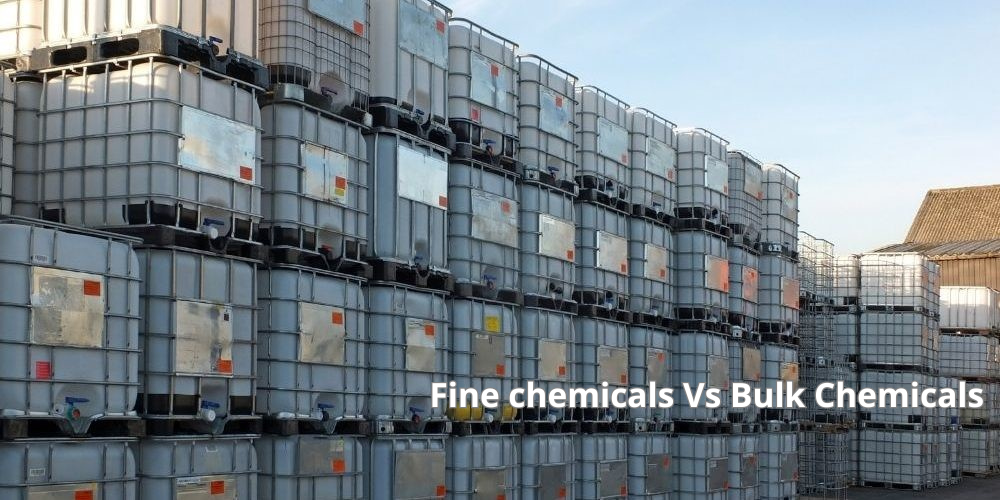Fine chemicals and bulk chemicals are both categories of chemicals, but they differ significantly in terms of production scale, cost, complexity, applications, and manufacturing processes. Here’s a detailed explanation of fine chemicals and how they differ from bulk chemicals:
What Are Fine Chemicals?
Fine chemicals are high-purity, complex, single-molecule chemicals produced in small quantities for specialized applications. These chemicals are typically used in industries such as pharmaceuticals, agrochemicals, electronics, and biotechnology.
- Characteristics of Fine Chemicals:
- High Purity: Fine chemicals must meet stringent purity requirements to ensure efficacy and safety.
- Low Volume, High Value: Produced in smaller quantities, often on a custom or demand-driven basis.
- Complex Manufacturing Processes: Require multi-step synthesis, precise conditions, and specialized expertise.
- Custom Specifications: Tailored to meet the needs of specific end-users or industries.
What Are Bulk Chemicals?
Bulk chemicals, also known as commodity chemicals, are produced on a large scale and are relatively simple in composition. These chemicals are widely used in everyday products and industrial processes.
- Characteristics of Bulk Chemicals:
- Lower Purity: Typically, they do not require the extremely high purity standards of fine chemicals.
- High Volume, Low Value: Produced in large quantities to serve widespread industrial needs.
- Simple Manufacturing Processes: Often involve straightforward chemical reactions or physical separations.
- Standardized Specifications: Manufactured to general industry standards rather than custom requirements.
Examples of Fine Chemicals
- Pharmaceutical Ingredients:
- Active pharmaceutical ingredients (APIs) like ibuprofen and atorvastatin.
- Agrochemicals:
- Specialty pesticides, herbicides, and fungicides.
- Electronics:
- High-purity chemicals for semiconductor manufacturing.
- Biotechnology:
- Enzymes, peptide synthesis reagents, and molecular biology kits.
Examples of Bulk Chemicals
- Petrochemicals:
- Ethylene, propylene, and benzene.
- Basic Inorganics:
- Sulfuric acid, ammonia, and sodium hydroxide.
- Polymers:
- Polyethylene, polypropylene, and PVC.
- Fertilizers:
- Urea, ammonium nitrate, and phosphates.
Applications of Fine Chemicals
- Pharmaceuticals:
- Used as APIs or intermediates in drug synthesis.
- Agrochemicals:
- Ingredients in crop protection products and fertilizers.
- Cosmetics:
- Active ingredients in skincare and personal care products.
- Electronics:
- High-purity etchants, dopants, and solvents for semiconductors.
- Research and Development:
- Specialty chemicals for lab-scale experiments and prototypes.
Applications of Bulk Chemicals
- Plastics and Polymers:
- Feedstocks for the production of synthetic materials.
- Energy:
- Components in fuels, lubricants, and energy storage.
- Construction:
- Ingredients in cement, adhesives, and paints.
- Water Treatment:
- Chemicals like chlorine for purification and disinfection.
- Textiles:
- Dyes and processing agents.
Economic Considerations
- Fine Chemicals:
- High Margins: Command premium prices due to their complexity and specificity.
- Capital-Intensive: Require significant investment in R&D, equipment, and skilled labor.
- Bulk Chemicals:
- Low Margins: Profits rely on volume rather than unit price.
- Scale-Driven: Benefit from economies of scale in production.
Challenges in Fine Chemicals Manufacturing
- Stringent Quality Standards:
- Meeting regulatory requirements for pharmaceuticals and other high-stakes applications.
- Complex Processes:
- Multi-step syntheses requiring precise control of reaction conditions.
- Cost Pressures:
- Balancing high production costs with market demand for affordability.
- Customization:
- Tailoring production to specific customer needs increases complexity.
Future Trends
- Fine Chemicals:
- Growth in Biotechnology:
- Increasing demand for enzymes, peptides, and other biotech-derived products.
- Advanced Materials:
- Use in emerging fields like nanotechnology and quantum computing.
- Growth in Biotechnology:
- Bulk Chemicals:
- Sustainability Focus:
- Transition to bio-based feedstocks and energy-efficient processes.
- Circular Economy:
- Recycling and upcycling of bulk chemicals to reduce waste.
- Sustainability Focus:
Conclusion
Fine chemicals and bulk chemicals serve distinct purposes in the global economy, with fine chemicals catering to niche, high-value applications and bulk chemicals meeting broad, industrial-scale needs. As industries evolve, the demand for both types of chemicals will continue to grow, with fine chemicals playing a pivotal role in innovation-driven sectors like pharmaceuticals, biotechnology, and electronics, while bulk chemicals remain essential for foundational industrial processes.
Hashtags
#FineChemicals #SpecialtyChemicals #HighValueChemicals #AdvancedChemicals #FineChemicalProduction #FineVsBulkChemicals #HighPurityChemicals #CustomChemicals #PrecisionChemicals #BulkChemicalProduction#FineChemicalsMarket #SpecialtyChemicalApplications #PharmaceuticalChemicals #BiotechChemicals #ConsumerProductChemicals #SmallScaleProduction #BatchProductionChemicals #CustomManufacturing #HighQualityChemicals #ComplexChemicalSynthesis #SustainableFineChemicals #GreenChemistryInFineChemicals #InnovativeFineChemicals

















